Abstract
The number of supermarkets offering grocery delivery has increased in recent years. Many studies conclude that CO2 emission savings result from this concept. Since the delivery of groceries also consumes energy and produces emissions, break-even points can be calculated, where the delivery is environmentally beneficial compared to customer pickup. In this paper, influences of differing vehicle use on break-even points for savings of energy and CO2 emissions are analyzed for the case of Haidhausen Süd, a district in Munich, Germany. Internal combustion engine and electric vehicles are investigated to depict current as well as future trends. After an introduction to the methodology used, the potential to save energy and CO2 emissions related to the delivery of groceries in the chosen district of Munich are evaluated. Subsequently, influences on the break-even points are presented and discussed. As the results show, a delivery of groceries leads to energy and carbon dioxide savings in a wide range of private vehicle use for grocery shopping trips. Nevertheless, if the complete customer vehicle fleet is electrified, the use of delivery vehicles with an internal combustion engine could cause an additional environmental impact at the current modal split for shopping trips in Germany.
1. Introduction
Nowadays, cities are confronted by traffic problems, resulting in increasing environmental impacts. Looking at the traffic volume of motorized private transport in Germany in 2017, 17.5% [1] results from shopping trips. After leisure trips (35.4%) and commuting (20.0%), this occupies the third position in official statistics [1]. As a proportion of all shopping trips relates to the supply of foodstuffs, the delivery of groceries instead of an individual customer pickup offers a chance to reduce traffic in cities. In this respect, tours by delivery vehicles can substitute customer shopping trips. This scenario simultaneously offers an opportunity for reducing energy and carbon dioxide emissions.
In many studies, the delivery of goods is compared to customer pickup. Siikavirta et al. [2] analyze this scenario in a case study for a grocery shop in Finland. There, the substitution of shopping trips by delivery would lead to a reduction of CO2 emissions in the range from 18% to 87%. Similar results were presented by Halldórsson et al. [3]. The authors investigated the specific CO2 emissions for delivery and customer pickup by averaging various statistical data. While a delivery would lead to emissions of 181 g CO2 per drop, the customer pickup scenario would emit around 4274 g CO2. They also examined the influence of the success rate of first delivery on the specific emissions. If the first delivery is not successful, the emissions are clearly increased.
Since the delivery of groceries can be seen as a case of deliveries on the last mile of city logistics, many scientific papers deal with this part of the supply chain. Thereby, the energy efficiency over this last part of a delivery chain is often discussed [4]. In general, the last mile is seen as the least efficient part of a supply chain [5]. Because of customer requirements, such as fast and reliable delivery, many delivery vehicles are used, resulting in a low average vehicle utilization [6]. Hence, different optimization approaches were developed in order to reduce the environmental impact of deliveries in this part of the supply chain. Bányai [7], for example, presents a real-time optimization model in order to increase energy efficiency. Since the delivery vehicle’s drivetrain affects energy consumption and emissions, the use of electric delivery vehicles is seen as an alternative to internal combustion engine vehicles [8]. Due to high costs, the use of battery electric vehicles is not yet profitable today, but might be viable in the near future [9,10]. Davis and Figliozzi [11] analyzed the competitiveness of electric compared to diesel delivery vans. Evaluating the results of their model, they name different factors, such as fleet size, battery life, and route characteristics as important influencing parameters for the competitiveness of electric delivery vehicles. Oliveira et al. [12] carried out a systematic literature review on the use of different delivery vehicles on the last mile, which offer the opportunity to increase sustainability. In addition to electric delivery vehicles, they reviewed the use of bicycles and tricycles, as well as smaller commercial vehicles, as alternatives. Moreover, autonomous delivery vehicles are under development, but the legal situation still needs to be clarified for future productive use [13]. In general, the use of intermodal transportation, or a shift to other transportation modes, offers a chance to influence the environmental aspects of deliveries [14]. Göçmen et al. [15], for example, use ecologic, economic, as well as social impact factors to optimize the intermodal transportation network of a logistics company in Turkey.
Looking at the delivery of groceries, the approach of a modal shift to reduce environmental impacts can also be identified. Using a delivery based approach, the transportation of groceries is shifted from individual shopping trips to a set of delivery van tours. As the delivery of foodstuffs also consumes energy and emits CO2, it also forms a possible ecological load. Hence, break-even points must be analyzed to determine from what point the delivery of groceries is environmentally more beneficial than individual shopping trips. In other words, as motorized private transport is mainly responsible for the energy consumption and emissions of individual shopping trips [16], minimum shares of private vehicle use in order to avoid additional energy consumption and CO2 emissions caused by the delivery must be evaluated. In order to rate the environmental impact and increase the sustainability of future grocery supply of cities, the knowledge of those break-even points is relevant for different stakeholders, such as governments, city administrations, possible users of grocery deliveries, and delivery services.
The aim of this paper is to introduce a modeling approach based on real-world geodata and Monte Carlo simulations in order to identify and analyze these break-even points for energy consumption and CO2 emissions in the case of Haidhausen Süd, a district in the center of the city of Munich, Germany. Using the model, the general potential to reduce energy and carbon dioxide emissions by delivery of groceries is first analyzed. As the use of freight electric vehicles for deliveries in city logistics becomes more and more popular, the evaluations address Internal Combustion Engine Freight Vehicles (ICEFV), as well as Electric Freight Vehicles (FEV). In relation to the goals of the German government to reduce the environmental impact of the transportation sector [17], the use of electric vehicles in the field of motorized private transport is named. Hence, the influence of a complete electrification of the German private vehicle fleet on break-even points is integrated in the analyses of this paper.
Brown et al. [18] also analyzed break-even points for carbon dioxide emissions. For this purpose, they compared the customer pickup to the delivery with combustion-engine delivery vans. Davis and Figliozzi [11] integrated FEVs in their study and calculated economic break-even points, depending on different parameters. Martín et al. [19] analyzed trends and research gaps in the field of e-groceries, which can be seen as directly related to the delivery of foodstuffs. Their investigations showed that this research topic plays a minor role in Germany in recent years. This fact is affirmed looking at the cited studies of Brown et al. [18], Siikavirta et al. [2], and Davis and Figliozzi [11], dealing with comparisons in the United States and Finland. As the electricity mix has a huge influence on the carbon dioxide emissions of electric vehicles [20] and the use of different transportation modes for grocery shopping is influenced by the country-specific behavior of customers [18], it is necessary to analyze break-even points for Germany.
Hence, this paper focuses on the following points:
- An assessment methodology for the investigation of energy and CO2 savings as well as break-even points based on real-world geodata derived from OpenStreetMap and Monte Carlo simulations is presented
- The use of electric vehicles for the delivery of groceries
- Break-even points for energy and carbon dioxide emissions
- Impact evaluation of electric and combustion-engine private vehicle fleets for customer pickup trips on possible savings
- Evaluation of two different amounts of delivered customers
- Results analysis for a district of Munich, Germany
Following the introduction, Section 2 presents the used materials and methods. This section first describes the calculation of the distances the delivery vehicles and customers must drive. For this purpose, geodata from OpenStreetMap [21] is used in combination with a Monte-Carlo-Simulation. Then, the approach to calculate energy consumption and emissions of delivery vans and private vehicles is introduced. In Section 3, results are presented and discussed. Here, the potential to save energy and CO2-emissions by a delivery of groceries in Haidhausen Süd using ICEFV and FEV is analyzed and discussed. To do so, the modal split of customer shopping trips in Germany is used. Subsequently, the break-even points, influenced by the already named parameters, are analyzed. Section 4 draws conclusions based on the results and gives an outlook.
2. Materials and Methods
Figure 1 shows the structure of the methodology. Based on characterizing data of the investigated region (Section 2.1), the average distance per shopping trip, as well as the average distance covered by the delivery vehicles, is calculated (see Section 2.2). Knowing the distances, energy consumption and carbon dioxide emissions are calculated using specific values (Section 2.3). Based on these energy consumptions and CO2 emissions, break-even points can subsequently be calculated. By varying the parameters of the private vehicle fleet, as well as of the delivery vehicles, influences on the break-even points can be analyzed. In the following, the methodology is described in detail.
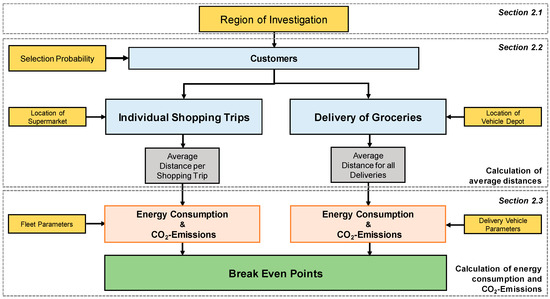
Figure 1.
Methodology of the study.
2.1. Region of Investigation
As a region representative of Munich, Haidhausen Süd, a part of the city district Au/Haidhausen, is used as the region of investigation in this paper. In 2016, this region had a population of about 14,400 inhabitants and approximately 7600 apartments or households. Based on an area of about 0.795 km2, this implies a population density of about 18,100 inhabitants/km2 and about 9560 apartments or households per square kilometer [22]. With an average number of 12.5 households per building, Haidhausen Süd is representative of an urban structure. One grocery store is selected as the main purchasing point for the customers. This supermarket is located near to the center of Haidhausen Süd at Pariser Platz. The depot from which the delivery vehicles start from and return to in order to delivery groceries in the evaluations of this paper is assumed to be at the southeastern city boundary of Munich. Hence, the delivery vehicles have to drive approximately 7 km to reach Haidhausen Süd. The supply of the supermarket with goods is neither taken into account, nor included in the balance. Figure 2 gives a brief overview of the region of investigation. The red marker represents the position of the supermarket.
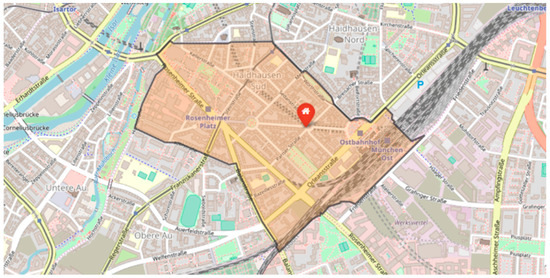
Figure 2.
Overview of Haidhausen Süd (Map: [21]).
2.2. Calculation of Average Distances
Figure 3 shows schematically the differences between delivery and customer pickup. In order to calculate the average distances, customer trips (Figure 3a) and delivery tours (Figure 3b) must be planned. Since the spatial distribution of the customers and the spatial properties of the delivery areas affect the distances, different sets of delivered customers in the defined region must be investigated to estimate the average distances. Therefore, a set of households is picked randomly using a selection probability. This set represents the customers who decided to have their groceries delivered instead of driving to the supermarket to purchase and collect them. Since the delivery can be seen as a consolidation and substitution of customer grocery purchases, it is irrelevant at which time the delivery tours or customer shopping trips take place. Investigating and evaluating a sufficiently high number of single sets of customers receiving deliveries allows an average value of the distances to be estimated. Compared to the random selection of points within a certain radius around the depot presented in [18] and [23], the calculation in this paper is based on data from OpenStreetMap [21]. For this purpose, all buildings within the borders of Haidhausen Süd are extracted and a street graph is created to calculate the full distance matrix of the region.

Figure 3.
Customer Trips to the Supermarket (a) and Delivery Vehicle Round Tour (b).
2.2.1. Creation of Delivery Samples
To create sets of customers for the estimation of the distances, a decision procedure for the selection of households must be developed. For this purpose, the delivery probability is used. It can be defined as the probability that one household from the quantity of all households in the region of investigation orders groceries instead of driving to the supermarket. As Equation (1) shows, the Bernoulli-Experiment of the decision procedure can be written with a random variable , where is a uniformly distributed random number in the interval [0, 1)
In 2018, according to EUROSTAT [24], within the last 12 months 24% of all German people living in areas with high population density ordered groceries or food online. As this indicator showed values of 9% in 2009, a rapid growth in this segment of e-commerce can be determined. In order to depict this fact, is defined within this paper, such that one in ten or two in ten supermarket customers use the delivery service instead of driving to the supermarket. Hence, the delivery probabilities are 10% and 20% respectively. Although no accurate percentage of delivered customer grocery purchases can be calculated, the assumptions for are justified in order to depict current trends as well as future developments.
Since the delivery probability is defined for a household, the mapping of households to buildings in the examined region must be known. As the data of OpenStreetMap does not include this information, an assignment approach using the average base area per household is applied. Using this approach instead of employing accurate data (i.e., official data on inhabitants per building, building height, number of floors, etc.) ensures the methodology remains flexible for future investigations in other regions. Considering the sum of the base area per building of all buildings in the region of investigation, as well as the absolute number of households , can be written as
Applying Equation (3) to each building, it is possible to estimate the number of households per building . Buildings with large base areas (industrial buildings, tertiary sector buildings) are excluded to minimize the errors of this approach.
As delivery services usually apply delivery areas when serving delivering of the customers, the region of investigation is divided into clusters with an equal number of households. Considering the probability a household will be delivered, the number of households per delivery area can be expressed as shown in Equation (4). represents the number of households a vehicle can serve. is assumed to be constant due to constraints, such as vehicle size, maximum payload, and daily duration of delivery. Hence, the number of households per delivery area decreases with an increasing delivery probability.
Assuming that a delivery area is served by just one delivery vehicle, it is possible to calculate the number of deployed delivery vehicles in the examination region for a certain delivery probability, using Equation (5).
The clustering of households into delivery areas is performed using a Same-size k-Means-Algorithm [25]. Applying the already introduced random experiment to all households of one delivery area, a delivery sample is created. In addition to the creation of a random distribution of delivered customers in the delivery areas, this approach also depicts different amounts of served customers, and thus integrates different counts of applied delivery vehicles, as well as customer shopping trips, in the analyses.
2.2.2. Tours of Delivery Vehicles
As the order of the appearance of single households in the randomly created delivery sample does not represent a reasonable delivery tour, a vehicle routing algorithm is applied to minimize the tour length and create a feasible journey. Hence, it is assumed that the delivery vehicles use optimized routes. Without the use of delivery areas, the routing problem can be described as a Capacitated Vehicle Routing Problem (CVRP) with vehicles [26]. The degree of freedom is limited using the delivery areas, so the CVRP decomposes to Traveling Salesman Problems (TSP) [26]. The full distance matrix of the region was considered as a basis for the routing algorithm in order to include one-way streets. As the average length of the delivery tour depends solely on the vehicle capacity and not on the vehicle drive technology of the vehicle, the same delivery tours at certain delivery probabilities are used for ICEFVs and FEVs. To solve the TSP, the routing engine of Google Optimization Tools is involved [27].
To calculate the average distance a delivery vehicle has to drive, many delivery samples must be taken into account in order to depict different spatial distributions of possible customers. Considering the distance of the delivery tour for a certain delivery sample as a function of the delivery probability and spatial distribution of households , the calculation of the average distance a delivery vehicle must drive to serve the customers or the expected value of can be expressed using the Monte Carlo Estimator [28]:
where is the total number of investigated delivery samples. Described by the Strong Law of Large Numbers [29], must be sufficiently high in order to ensure a convergence of the Monte Carlo Simulation [30]. Multiplying the estimated average distance per delivery vehicle by the number of vehicles used or the number of delivery areas, the total average driven distance of all delivery vehicles required to serve the region can be calculated.
For the following examinations in Haidhausen Süd, it is assumed that the delivery vehicles have a total capacity of 200 deliveries. Hence, at a delivery probability of 10%, the region is divided into five delivery areas, while at 20%, nine delivery areas are used. Figure 4 shows the success for the estimation of using the introduced methodology for a delivery probability of 10%. For this evaluation, 1000 delivery samples were created, while taking into account that each delivery area is used for the same number of created delivery samples. It can be seen that the average distance a delivery vehicle has to drive to serve customers converges to stable values of around 18.4 km, while the standard deviation converges to values of around 0.9 km. As the standard deviation is relatively low compared to the average distance, it is neglected for the following analyses.
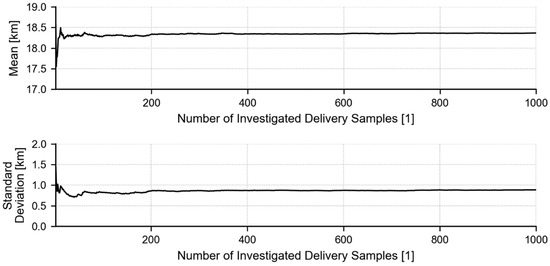
Figure 4.
Convergence of the Monte Carlo Simulation for the Estimation of the Average Distance of a Delivery Vehicle (Delivery Probability 10%).
Table 1 summarizes the calculated average distances per delivery vehicle and in total for a delivery probability of 10% as well as 20%. Since the distance between two vehicle stops for the delivery of goods decreases for an increasing delivery probability, the total distance per vehicle is reduced. In addition to this, the size of the delivery areas is reduced, so that the vehicle has to drive shorter distances to serve all customers. At the same time, as the number of delivery areas increases, the distance travelled by all delivery vehicles to serve Haidhausen Süd increases in total.

Table 1.
Characteristics of Grocery Delivery Tours in Haidhausen Süd.
2.2.3. Customers Shopping Trips
As the customers do not drive a circular tour, the trips need not be optimized. Assuming that customer trips always start and end at the household’s location, the distance can be expressed as
where describes the distance to drive from to . Using the full distance matrix of the region of investigation, can be calculated.
Since the location of the household in the region of investigation affects the distance of the shopping trip to the supermarket, the average distance of one trip is calculated considering all single trips of served customers in the delivery samples. However, the average distance is independent of the delivery probability, it is just influenced by the spatial properties of the region of investigation. Table 2 lists the calculated average distances per customer grocery shopping trip and in total for a delivery probability of 10% as well as 20%. Since the doubling of the delivery probability forces a selection of, on average, twice the number of customers, the total distance of customers’ shopping trips is also approximately doubled.

Table 2.
Characteristics of Customer Grocery Shopping Trips in Haidhausen Süd.
2.3. Energy Consumption and Emission Factors
Knowing the typical distances of the delivery vehicles as well as of the customer vehicles, the energy consumption and resulting CO2-Emissions can be calculated
where is the distance-specific energy consumption and is the driven distance; are the energy-specific CO2 emissions of a certain energy carrier.
2.3.1. Delivery Vehicle Fleet
Since the vehicle fleet of delivery services often compromises more than one specific vehicle type, datasheets of different vehicle manufacturers with a maximum total mass up to 3.5 t were evaluated in order to research the specific energy consumption. A volume for the cargo bay in the range of 5 m3 to 9 m3, which is in the middle range of all investigated vehicles, was assumed to have the already stated vehicle capacity of 200 deliveries. The maximum total weight was selected with the requirement that the delivery vehicles can be used with the regular driving license for motor cars in Germany. As vehicles with electric as well as combustion engine drive are investigated, the stated specific energy consumptions in the datasheets of the certain drive types were averaged to create typical FEVs as well as ICEFVs. This leads to average specific energy consumptions of 19.9 kWh/100 km for FEVs and 60.6 kWh/100 km for ICEFVs. As those specific energy consumptions were derived during test procedures, namely in the New European Driving Cycle (NEDC), a simple vehicle model based on driving resistances and efficiencies is used to obtain values that are more realistic. Assuming flat roads, the power at the wheels is just dependent on the instantaneous velocity and the acceleration . It can be written as
here the total mass of the vehicle can be split up into two components, where:
- represents the empty mass of the vehicle, including the driver and all necessary components for operating the vehicle (for example fuel, lubricants etc.)
- reflects the load mass of the vehicle, i.e., the mass of the delivered groceries.
To simplify the model, the load mass is set to constant instead of time-dependent, resulting in a non-decreasing vehicle mass during the delivery tour. To reproduce the vehicle mass reduction due to delivered groceries, is set to the half of the load mass when considering the whole vehicle capacity. Hence, this modification can be seen as the calculation of the vehicle with an average load mass. Assuming an average mass per delivered household of 2.5 kg, the total mass of the delivery vehicle can be written as
Since some additional vehicle characteristics must be known for the calculation of the power at the wheels, supplementary values of the vehicle manufacturer datasheets were averaged, resulting in typical empty mass , cross sectional area , and maximum engine power for FEV and ICEFV. While air density and gravity acceleration are given by physics, drag coefficient , rolling resistance coefficient , as well as rotating mass impact factor are assumed to have typical values. Table 3 shows the values used for the calculation of the power at the wheels.

Table 3.
Parameters for the Delivery Vehicle Energy Calculation.
As the characteristics of the drive profile of the vehicle (i.e., curve of velocity and acceleration against time) have a high influence on energy consumption, it is necessary to use values reflecting the characteristics of delivery vehicles. Thus, the NREL Baltimore Parcel Delivery [31] (BPDC) cycle was used for the energy demand simulations. In contrast to other drive cycles, BPDC shows a total of 41 stops with a huge number of acceleration and breaking procedures over a distance of around 33 km. For the application of this cycle in the following examinations, it is expected that:
- BPDC is representative for delivery vehicles in Haidhausen Süd
- Velocity and acceleration are not affected by different drive technologies of the vehicles, i.e., values of acceleration and deceleration are equal for all investigated vehicles.
In order to calculate the final energy demand of the delivery vehicles, the engine efficiency must be considered in addition the efficiency of components, such as gear and drive train, bundled together in
Due to the high number of stops, the engine of a delivery vehicle is working frequently at different points of utilization. For this case, the application of a constant efficiency would lead to errors in the calculation. Hence, an efficiency model for electric and internal combustion engines based on the current utilization from Brooker et al. [32] was integrated. There, the engine efficiency can be derived applying the calculated power at the engine shaft, as well as the maximum motor power . In contrast, the efficiency of remaining components is set to constant. The possibility of regenerative braking for electric vehicles is also considered using the approach of Brooker et al. [32]. Auxiliary consumers are not taken into account in the evaluations of this paper. Especially, refrigeration of the vehicle stowage is not considered. Applying (13), the specific final energy consumption can be calculated
where is the distance covered by the driving cycle.
In order to validate and calibrate the implemented vehicle model, the averages of the stated energy consumptions were compared to the simulation results. Therefore, the energy consumption was simulated in the NEDC, which was the underlying test cycle. At this stage, only the empty mass of the vehicle was taken into account. By varying the component efficiency, the model was calibrated to the average stated consumptions in NEDC. Using the calibrated model, the specific energy consumption in the BPDC was calculated. Table 4 summarizes the results. The simulated specific energy consumption in BPDC shows an increase of 7.5% compared to the stated value for FEVs. In the case of ICEFVs, the simulation results show a 21.5% increase compared to the average manufacturer data in NEDC. As no real-life energy consumptions of delivery vehicles in Munich were available for research, the simulated values must be seen as representative for the delivery of groceries in this region of investigation. Although a simple model was used for the calculation, the derived specific energy consumptions have a higher precision compared to the stated values, because a characteristic velocity and acceleration profile of delivery vehicles is used for the calculations. This leads to a higher rating of the following analyses.

Table 4.
Simulation Results for the Energy Consumption of Delivery Vehicles.
As all evaluated vehicles in the category ICEFV use diesel engines, the specific emissions of diesel fuel in Germany of 266.4 gCO2/kWh [33] are used for such vehicles. Since the use of electric vehicles produces CO2 emissions at the generating power plants, the average specific emissions of 489 gCO2/kWh [34] for the German electricity mix in 2017 are used to map this behavior for the case of FEVs.
2.3.2. Customer Vehicle Fleet
Neglecting the low percentage of alternative drive technologies, the German private vehicle fleet can be divided into diesel and petrol engine vehicles, embraced as Internal Combustion Engine Customer Vehicles (ICECV). Using the shares of the two engines [1] as well as the average fuel consumption of private cars in Germany [1], an average weighted specific energy consumption of 65.8 kWh/100 km can be calculated. The specific emissions of petrol in Germany at 263.2 gCO2/kWh [33], as well as the already given value for diesel fuel, lead to average weighted specific CO2 emissions of 264.2 gCO2/kWh for the German ICECV fleet. To investigate the influence of complete electrification of the German private vehicle fleet, a typical specific energy consumption of Electric Customer Vehicles (ECV) is assumed to be 15.0 kWh/100 km. This specific energy consumption reflects an electric vehicle fleet with an average battery capacity of 30 kWh and an average range of 200 km per vehicle. In the case of ECVs, it can be assumed that the charging electricity mix does not differ compared to FEVs, which leads to equal specific emissions.
The specific energy consumptions and CO2 emissions necessary for the calculation of the absolute values of all investigated vehicles in this paper are summarized in Table 5.

Table 5.
Specific Energy Consumption and Emissions of Investigated Vehicles.
2.3.3. Calculation of Break-Even-Points
Using the data of Table 5, the energy consumption and resulting CO2-Emissions of individual shopping trips using private vehicles can be written as
where is the total number of customer trips, is the average distance per trip, and is the percentage of private vehicle use for shopping trips; and are the specific energy consumption and specific CO2 emissions of the customer vehicles, respectively. In the same way, energy consumption and carbon dioxide emissions of the delivery vehicles can be expressed as
where is the driven distance of all delivery vehicles, is the specific energy consumption of the investigated delivery vehicle, and are the specific CO2 emissions of the delivery vehicle for a given energy carrier .
Neglecting other modes with environmental impact, the minimum shares of private vehicle use for grocery shopping trips in order to avoid additional energy consumption and CO2 emissions caused by the delivery or the break-even points can be calculated:
In order to visualize savings at different shares of private vehicle use in the range from 0% to 100%, the relative savings caused by the delivery of the groceries instead of individual shopping trips shown in (20) are used. Here, is either energy consumption or carbon dioxide emissions.
3. Results and Discussion
3.1. Potential for Saving of Energy and CO2 at the Current Share of Private Vehicle Use for Shopping Trips
It is well-known that not all customer shopping trips for groceries are executed with private vehicles. In order to identify the potential of a delivery of groceries to save energy and CO2, the modal split for shopping trips needs to be considered.
Figure 5 shows the modal split for shopping trips in Germany dependent of the community size [16]. The visualized values are valid for people who have permanent access to motorized private vehicles. Only shopping trips are considered. The use of motorized private transport clearly decreases as the number of inhabitants in a community increases. Combining the shares of driver and co-driver, in communities with less than 20,000 inhabitants, a share of 72% [16] uses private vehicles for its grocery shopping. Looking at cities with more than 500,000 inhabitants, only around 46.5% [16] use this mode. As this percentage decreases, other modes become more popular. Due to reduced distances to the nearest shopping facility, there is a higher share of pedestrian or cyclist shoppers. Equally, a higher share uses public transport for this application. This can be traced back to a higher availability of this mode plus a higher serving rate of public transport. The availability of parking lots as well as the traffic flow in cities can also be seen as drivers for the reduced percentage of motorized private transport used for shopping trips [16].
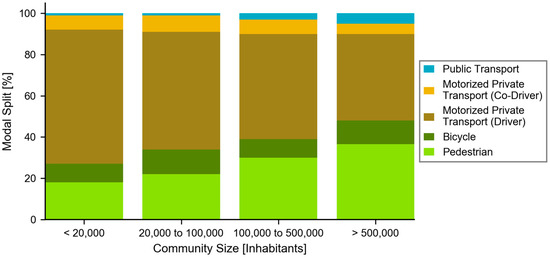
Figure 5.
Modal Split for Shopping Trips in Germany depending on the community size (data derived from [16]).
As Haidhausen Süd is a part of the city of Munich, which has around 1.45 million [22] inhabitants, the modal split for communities with more than 500,000 inhabitants is used for further investigation. Applying data for communities with a lower number of inhabitants would not reflect the urban structure of Haidhausen Süd. Hence, Table 6 summarizes the distribution of the shopping trips amongst the different traffic modes for a delivery probability of 10% and 20% in Haidhausen Süd. Here, the shares of motorized private transport or simplified use of private vehicles are the major drivers for energy consumption and carbon dioxide emissions caused by private shopping trips. Neglecting the low percentage of public transport, and based on the fact that cyclist or pedestrian shopping trips do not consume energy or produce carbon dioxide emissions, this statement can be approved.

Table 6.
Modal Split of Customer Grocery Shopping Trips in Haidhausen Süd.
Using the data from Table 6, at a delivery probability of 10% a total distance of approximately 388 km is covered by private vehicles. Doubling the amount of delivered customers, a total of 775 km is driven by this mode. With those distances, the potential to save energy at the current share of private vehicle use can be evaluated. Figure 6 compares the energy demand of ICECVs at the current share of private vehicle use for grocery shopping (46.5%) with the energy consumption of FEVs and ICEFVs. At both investigated delivery probabilities, a grocery delivery would lead to energy savings. Due to the higher efficiency or lower specific energy consumption of FEVs, the absolute as well as relative savings show higher values when using those vehicles. As the doubling of the amount of delivered customers leads not to a doubling of the energy use of the delivery vehicles, the energy savings are not constant at different delivery probabilities.
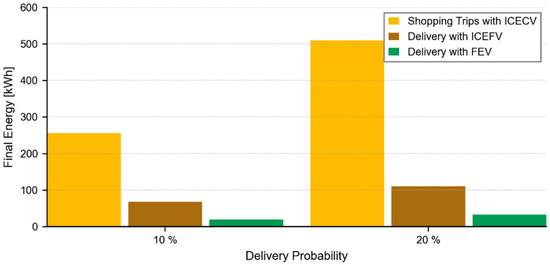
Figure 6.
Potential to save energy by the delivery of groceries in Haidhausen Süd for different drive types of delivery vehicles (Customer Vehicles: ICECV; share of private vehicles use for shopping trips, 46.5 %).
Table 7 gives an overview of absolute and relative energy savings. Even at the share of private vehicle use of 46.5%, the delivery of groceries with ICEFVs would lead to energy savings of around 73.6% and 78.4% compared to individual shopping trips with ICECVs, at a delivery probability of 10% and 20%, respectively. The energetic advantages of FEVs lead to savings of 92.3% and 93.7%.

Table 7.
Absolute and Relative Energy Savings.
Looking at the CO2 emissions (Figure 7), delivery instead of customer pickup would also lead to savings. Here, the relative CO2 savings in the case of a delivery with ICEFVs show almost the same values when compared to the energy savings, because the emission factors of ICEFVs and ICECVs are more or less equal. Applying FEVs for the delivery of groceries, the CO2 savings are decreased compared to energy savings. This fact arises from the significantly higher specific emissions of the electricity mix compared to the German private vehicle fleet. Based on Table 8, relative as well as absolute savings of CO2 can be concretized. At a delivery probability of 10%, the use of ICEFVs instead of customer shopping trips would lead to CO2 savings of around 49.5 kgCO2 per delivery tour, or 73.3%. Using FEVs, the absolute savings increase to a value of approximately 58 kgCO2, or 85.8%.
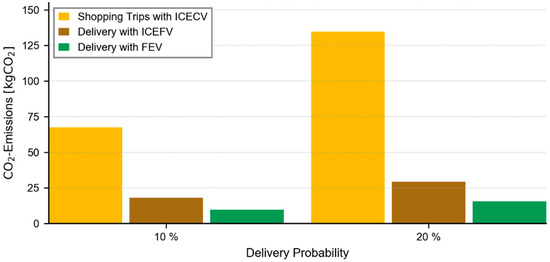
Figure 7.
Potential to save CO2 emissions by the delivery of groceries in Haidhausen Süd for different investigated drive types of delivery vehicles (Customer Vehicles: ICECV; share of private vehicles use for shopping trips, 46.5%).

Table 8.
Absolute and Relative CO2 Savings.
Combining the results, the delivery of groceries in this district of the city of Munich would provide an opportunity to save energy and CO2.
3.2. Analysis of Break-Even Points for Energy Consumption
Figure 8 shows the resulting energy savings at a delivery probability of 10% for shares of private vehicle use in the range from 0% to 100%. Neglecting public transport again, the minimum share of private vehicle use to generate energy savings or the break-even point is visualized as the intersection of the saving-curves with the axis of private vehicle share.
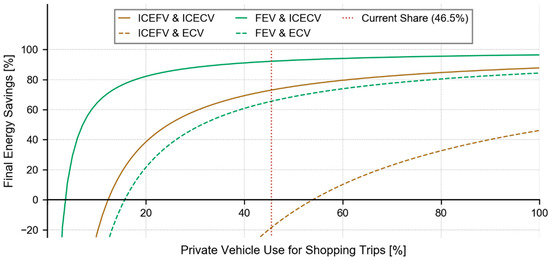
Figure 8.
Final Energy Savings caused by a delivery of groceries as a function of the percentage of vehicle use for individual shopping trips (Delivery Probability 10%).
Looking at the curve of customer and delivery vehicles with combustion engines (ICEFV + ICECV), a delivery would offer the chance to save energy at shares greater than 12.3%. Since the FEVs consume less energy than ICEFVs, this minimum share is reduced to 3.6% (FEV + ICECV). As ECVs show a lower energy consumption than ICECVs, the minimum share of customer trips for energy savings is increased in general, when looking at an electrified customer vehicle fleet. The view on FEVs and ECVs (FEV + ECV) leads to a minimum share of 15.7%. In the case of a delivery with ICEFVs, ECVs would lead to an intersection at 53.9% (ICEFV + ECV). Assuming a constant modal split for future developments, this scenario would lead to additional energy consumption or no savings caused by the delivery, as the current share of private vehicle use is 46.5%. Since all other named scenarios show break-even points below this share, this leads to the statement that electrification of the customer vehicle fleet requires the electrification of delivery vehicles for energy savings still to be made.
In contrast to the break-even points, a share of 100% reflects the fact that all customers use private vehicles for shopping trips. There, the use of FEVs and a customer vehicle fleet consisting of ICECVs leads to the highest savings. The use of ICEFVs in combination with ECVs would offer the chance to save around 45% of energy. In general, the relative savings increase with an increasing share of private vehicle use. In addition to the shifting of the break-even point, a decreasing specific energy consumption of the private vehicle fleet is damping to the curve of the savings.
The doubling of the amount of served customers leads to a left-shift of the savings-curves (Figure 9), resulting in lowered cutting-points and higher savings at a share of 100%. The course of the savings is affected by the increase of the energy consumption of the delivery vehicles. At a delivery probability of 20%, the use of ICEFVs compared to a fleet of ECVs would offer the opportunity to save energy at the current share of private vehicle use for shopping trips. In general, the left-shift derives from the increased absolute number of substituted shopping trips.
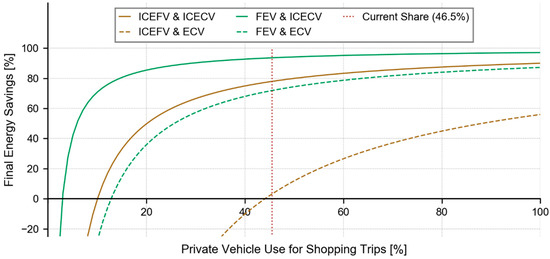
Figure 9.
Final Energy Savings caused by a delivery of groceries as a function of the percentage of vehicle use for individual shopping trips (delivery Probability 20%).
Except for the investigation of ICEFV + ECV at a delivery probability of 10%, all depicted scenarios would lead to energy savings at the current share of private vehicle use for grocery shopping.
3.3. Analysis of Break-Even Points for CO2 Emissions
Compared to the energy savings, the break-even of carbon dioxide savings are clearly different in some scenarios. Figure 10 and Figure 11 show the results for a delivery probability of 10% and 20%, respectively.
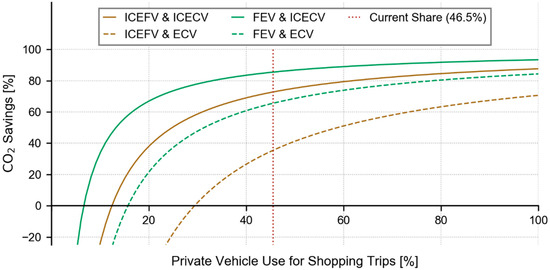
Figure 10.
CO2 savings caused by a delivery of groceries as a function of the percentage of vehicle use for individual shopping trips (Delivery Probability 10%).
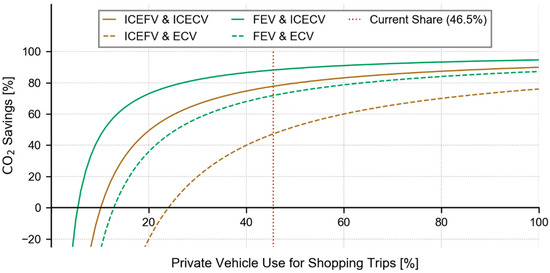
Figure 11.
CO2 savings caused by a delivery of groceries as a function of the percentage of vehicle use for individual shopping trips (Delivery Probability 20%).
The use of ICEFVs for the delivery of groceries instead of individual shopping trips by an ECV-fleet would offer the chance of reducing CO2-emissions starting at shares greater than 29.4%, at a delivery probability of 10%. The distinct lowering of the break-even point compared to energy savings (53.9%) in this case derives from the high difference between the specific CO2-emissions of electricity and diesel fuel. Decreasing specific emissions of the charging electricity mix would result in higher minimal shares of private vehicle use in order to generate savings. As the reduction of specific emissions of the electricity mix is a declared goal for future development, the statement derived at the analysis of energy savings for this scenario is supported. Assuming a constant modal split for shopping trips in future, a complete electrification of the private vehicle fleet must presuppose the use of FEVs for the delivery of groceries simultaneously to save CO2.
This behavior is depicted in the scenario of FEV + ECV. There, the minimum shares of private vehicle use are equal to the ones derived for analysis of energy savings for both examined delivery probabilities. This can be drawn back to the equal specific emissions of the charging electricity mix.
Looking at the use of ICEFVs in contrast to an ICECV-Fleet, the break-even point is also almost constant compared to energy savings. Since the specific emissions of those vehicle types are more or less the same, the share is almost unchanged. While the share for saving energy is 12.3%, it increases marginally to 12.4% when considering the CO2 savings at a delivery probability of 10%.
Lastly, the consideration of FEVs and ICECVs leads to increased break even points of emissions compared to the energy savings. At a delivery probability of 10%, a minimum of approximately 6.6% of all shopping trips must be accomplished by private vehicles in order to save carbon dioxide. This behavior again can be lead back to the difference between the specific emissions.
With a view to doubling the amount of customers using the delivery of groceries, the same tendency as already described for the break-even points of CO2 emissions can be observed. In contrast to energy savings, all depicted scenarios would lead to CO2 savings at the current share of private vehicle use for grocery shopping, considering the current specific emissions. Table 9 puts together the results for the break-even points in order to save energy and carbon dioxide in Haidhausen Süd by a delivery of groceries.

Table 9.
Minimum Shares for Private Vehicle Use in Shopping Trips to Save Energy and Emissions.
4. Conclusions and Outlook
The results of this paper show that the delivery of groceries in Haidhausen Süd, a district of the city of Munich, has the potential to save energy and CO2 compared to individual shopping trips. A distinctive finding is that not only combustion-engine, but also electric delivery vehicles, have the potential to save energy and CO2. Another finding is that the substitution of customer shopping trips by FEVs leads to higher relative CO2 savings than the use of ICEFVS, which derives from the higher efficiency of electric vehicles, although the specific emissions of the German electricity mix clearly are higher compared to diesel fuel. The fact that even the use of ICEFVs offers the opportunity to save energy and CO2 compared to individual customer shopping trips calls into question whether FEVs are necessary to decrease the environmental impact. On the one hand, the use of FEVs offers the opportunity of a diversification of energy sources through sector coupling and helps to improve the sustainability of transportation. On the other hand, the purchase costs of FEVs are currently rather [9,10]. Although the use of FEVs might not be economically profitable yet, the use of FEVs for the delivery of groceries is an option to further decrease the environmental impact compared to customer pickup and the use of ICEFVs.
As the results showed, the delivery of groceries leads to savings across a wide range of private vehicle use for shopping trips in Haidhausen Süd. This statement is supported by the location of the break-even points, marking the share of private vehicle use where the delivery starts to be environmentally beneficial compared to individual grocery shopping trips with private vehicles. Hence, even if a huge share of customers shifts to environmentally friendly modes for the shopping of groceries, a delivery would still offer opportunities to save energy and CO2. This statement is also valid if the average distance of one customer pickup increases, for example, if the supermarket is located at the borders of the region of investigation. Therefore, the delivery would show benefits even at lower shares of private vehicle use. Consequently, the length of a customer shopping trips has a huge effect on the break-even points or savings. On the other hand, if the depot of the delivery vehicles is located further away from the region of investigation, savings may be reduced. Additionally, the quantity of avoided customer shopping trips affects the savings. As the number of substitutions increases, more delivery vehicles must be employed. Hence, the results indicate higher energy use and CO2 emissions of the delivery vehicles.
The results of the paper can be summarized in the following:
- Specific energy consumption and specific CO2 emissions of private as well as delivery vehicles clearly affect the position of break-even points
- Break-even points for energy use and carbon dioxide emissions must be evaluated independently of each other, because the results can differ
- When internal combustion-engine delivery vehicles are used, a complete electrification of the private vehicle fleet can cause additional energy consumption at the current share of private vehicle use for shopping trips in Germany
- In this case, a reduction of the specific CO2 emissions of the electricity mix could also lead to additional emissions caused by the delivery
- At the current share of private vehicle use, an electrification of the private vehicle fleet requires the use of electric delivery vehicles in the future if energy savings and emission reductions are still to be made
Interpreting the results, the limitations of this study have to be considered, as they can affect the positions of the break-even points:
- The trips of the customers start and end at the same positions. Chained customer shopping trips are not considered. The integration of the grocery purchase in other trips (for example in the trip to return from work) leads to a shift of the break-even points as the distances of customer trips decrease. Hence, more customers can use the private vehicle for grocery shopping to reach the energy consumption and CO2 emissions of the delivery vehicles.
- Time windows for delivery are not considered in the optimization of the route; the integration of this approach would also lead to a shift of the break-even points, since the distance covered by the delivery vehicles changes. In addition to that, perhaps more delivery vehicles must be employed.
- The refrigeration of the stowage of the delivery vehicles is not considered; a consideration would lead to higher specific energy consumption, resulting in a shift of the break-even points.
Since new concepts for urban mobility have been developed in recent years, the share of private vehicle use might change in the future. The methodology presented in this paper can be used for future evaluations of break-even points and potentials for energy savings and reductions in emissions. For future research, the effects of the ongoing decarbonization of the German electricity mix on break-even points should be analyzed in detail. Here, the influence of a time-shift of deliveries in order to use time slots with low carbon dioxide intensity for the charging of electric vehicles should be investigated.
Author Contributions
L.H. designed the study and evaluated the results. He was also responsible for the development of the methodology. U.W. performed the scientific overview and discussed the results together with L.H. All authors agreed with the final version of the paper.
Funding
This work was supported by the German Research Foundation (DFG) and the Technical University of Munich (TUM) in the framework of the Open Access Publishing Program.
Conflicts of Interest
The authors declare no conflict of interest. The funders had no role in the design of the study; in the collection, analyses, or interpretation of data; in the writing of the manuscript, or in the decision to publish the results.
References
- Bundesministerium für Verkehr und digitale Infrastruktur (BMVI). Verkehr in Zahlen 2017/2018: 46. Jahrgang: Berlin, Germany, 2017. Available online: https://www.bmvi.de/SharedDocs/DE/Publikationen/G/verkehr-in-zahlen-pdf-2017-2018.pdf (accessed on 21 January 2019).
- Siikavirta, H.; Punakivi, M.; Kärkkäinen, M.; Linnanen, L. Effects of E-Commerce on Greenhouse Gas Emissions: A Case Study of Grocery Home Delivery in Finland. J. Ind. Ecol. 2002, 6, 83–97. [Google Scholar] [CrossRef]
- Halldórsson, Á.; Edwards, J.B.; McKinnon, A.C.; Cullinane, S.L. Comparative analysis of the carbon footprints of conventional and online retailing. Int. J. Phys Distrib. Logist. Manag. 2010, 40, 103–123. [Google Scholar] [CrossRef]
- Wehner, J. Energy Efficiency in Logistics: An Interactive Approach to Capacity Utilisation. Sustainability 2018, 10, 1727. [Google Scholar] [CrossRef]
- Ranieri, L.; Digiesi, S.; Silvestri, B.; Roccotelli, M. A Review of Last Mile Logistics Innovations in an Externalities Cost Reduction Vision. Sustainability 2018, 10, 782. [Google Scholar] [CrossRef]
- Kin, B.; Ambra, T.; Verlinde, S.; Macharis, C. Tackling Fragmented Last Mile Deliveries to Nanostores by Utilizing Spare Transportation Capacity—A Simulation Study. Sustainability 2018, 10, 653. [Google Scholar] [CrossRef]
- Bányai, T. Real-Time Decision Making in First Mile and Last Mile Logistics: How Smart Scheduling Affects Energy Efficiency of Hyperconnected Supply Chain Solutions. Energies 2018, 11, 1833. [Google Scholar] [CrossRef]
- Teoh, T.; Kunze, O.; Teo, C.-C.; Wong, Y. Decarbonisation of Urban Freight Transport Using Electric Vehicles and Opportunity Charging. Sustainability 2018, 10, 3258. [Google Scholar] [CrossRef]
- Faccio, M.; Gamberi, M. New City Logistics Paradigm: From the “Last Mile” to the “Last 50 Miles” Sustainable Distribution. Sustainability 2015, 7, 14873–14894. [Google Scholar] [CrossRef]
- Juan, A.; Mendez, C.; Faulin, J.; de Armas, J.; Grasman, S. Electric Vehicles in Logistics and Transportation: A Survey on Emerging Environmental, Strategic, and Operational Challenges. Energies 2016, 9, 86. [Google Scholar] [CrossRef]
- Davis, B.A.; Figliozzi, M.A. A methodology to evaluate the competitiveness of electric delivery trucks. Transp. Res. E Logist. Transp. Rev. 2013, 49, 8–23. [Google Scholar] [CrossRef]
- Oliveira, C.; Albergaria De Mello Bandeira, R.; Vasconcelos Goes, G.; Schmitz Gonçalves, D.; D’Agosto, M. Sustainable Vehicles-Based Alternatives in Last Mile Distribution of Urban Freight Transport: A Systematic Literature Review. Sustainability 2017, 9, 1324. [Google Scholar] [CrossRef]
- Hoffmann, T.; Prause, G. On the Regulatory Framework for Last-Mile Delivery Robots. Machines 2018, 6, 33. [Google Scholar] [CrossRef]
- Tawfik, C.; Limbourg, S. Pricing Problems in Intermodal Freight Transport: Research Overview and Prospects. Sustainability 2018, 10, 3341. [Google Scholar] [CrossRef]
- Göçmen, E.; Erol, R. The Problem of Sustainable Intermodal Transportation: A Case Study of an International Logistics Company, Turkey. Sustainability 2018, 10, 4268. [Google Scholar] [CrossRef]
- Bundesministerium für Verkehr, Bau und Stadtentwicklung (BMVBS). Ohne Auto einkaufen: Nahversorgung und Nahmobilität in der Praxis; BMVBS: Berlin, Germany, 2011. [Google Scholar]
- Bundesministerium für Umwelt; Naturschutz; Bau und Reaktorsicherheit (BMUB). Klimaschutzplan 2050—Klimaschutzpolitische Grundsätze und Ziele der Bundesregierung 2016. Available online: https://www.bmu.de/fileadmin/Daten_BMU/Download_PDF/Klimaschutz/klimaschutzplan_2050_bf.pdf (accessed on 22 January 2019).
- Brown, J.R.; Guiffrida, A.L. Carbon emissions comparison of last mile delivery versus customer pickup. Int. J. Logist. Res. Appl. 2014, 17, 503–521. [Google Scholar] [CrossRef]
- Martín, J.; Pagliara, F.; Román, C. The Research Topics on E-Grocery: Trends and Existing Gaps. Sustainability 2019, 11, 321. [Google Scholar] [CrossRef]
- van Vliet, O.; Brouwer, A.S.; Kuramochi, T.; van den Broek, M.; Faaij, A. Energy use, cost and CO2 emissions of electric cars. J. Power Sources 2011, 196, 2298–2310. [Google Scholar] [CrossRef]
- OpenStreetMap Contributors. OpenStreetMap. Available online: https://www.openstreetmap.org/ (accessed on 21 January 2019).
- Statistisches Amt der Landeshauptstadt München. Statistische Daten für Haidhausen Süd. 2018. Available online: http://www.mstatistik-muenchen.de/indikatorenatlas/atlas.html (accessed on 21 January 2019).
- Brown, J.R.; Guiffrida, A.L. Stochastic Modeling of the Last Mile Problem for Delivery Fleet Planning. J. Transp. Res. Forum 2017, 56, 93–108. [Google Scholar]
- EUROSTAT. Internet Purchases by Individuals: Online Purchases of Food and Groceries; EUROSTAT: Luxembourg, 2018. [Google Scholar]
- ELKI Data Mining. Same-Size k-Means Variation. 2018. Available online: https://elki-project.github.io/tutorial/same-size_k_means (accessed on 28 November 2018).
- Domschke, W.; Scholl, A. Logistik: Rundreisen und Touren, 5th ed.; Walter de Gruyter GmbH & Co KG: Berlin, Germany, 2010. [Google Scholar]
- Google Optimization Tools. 2018. Available online: https://developers.google.com/optimization/ (accessed on 21 January 2019).
- Owen, A.B. Monte Carlo Theory, Methods and Examples. 2013. Available online: http://statweb.stanford.edu/~owen/mc/ (accessed on 18 January 2019).
- Steland, A. Basiswissen Statistik: Kompaktkurs für Anwender aus Wirtschaft, Informatik und Technik, 3rd ed.; Springer: Berlin/Heidelberg, Germany, 2013. [Google Scholar]
- Graham, C.; Talay, D. Stochastic Simulation and Monte Carlo Methods: Mathematical Foundations of Stochastic Simulation; Springer: Berlin/Heidelberg, Germany, 2013. [Google Scholar]
- Kelly, K.; Prohaska, R.; Ragatz, A.; Konan, A. NREL DriveCAT, Chassis Dynamometer Test Cycles. 2016. Available online: https://www.nrel.gov/transportation/drive-cycle-tool/ (accessed on 4 December 2018).
- Brooker, A.; Gonder, J.; Wang, L.; Wood, E.; Lopp, S.; Ramroth, L. FASTSim: A Model to Estimate Vehicle Efficiency, Cost and Performance. SAE Tech. Pap. 2015. [Google Scholar] [CrossRef]
- Umweltbundesamt. CO2-Emissionsfaktoren für fossile Brennstoffe; Umweltbundesamt: Dessau, Germany, 2016. [Google Scholar]
- Umweltbundesamt. Entwicklung der spezifischen Kohlendioxid-Emissionen des Deutschen Strommix in den Jahren 1990–2017; Umweltbundesamt: Dessau, Germany, 2018. [Google Scholar]
© 2019 by the authors. Licensee MDPI, Basel, Switzerland. This article is an open access article distributed under the terms and conditions of the Creative Commons Attribution (CC BY) license (http://creativecommons.org/licenses/by/4.0/).